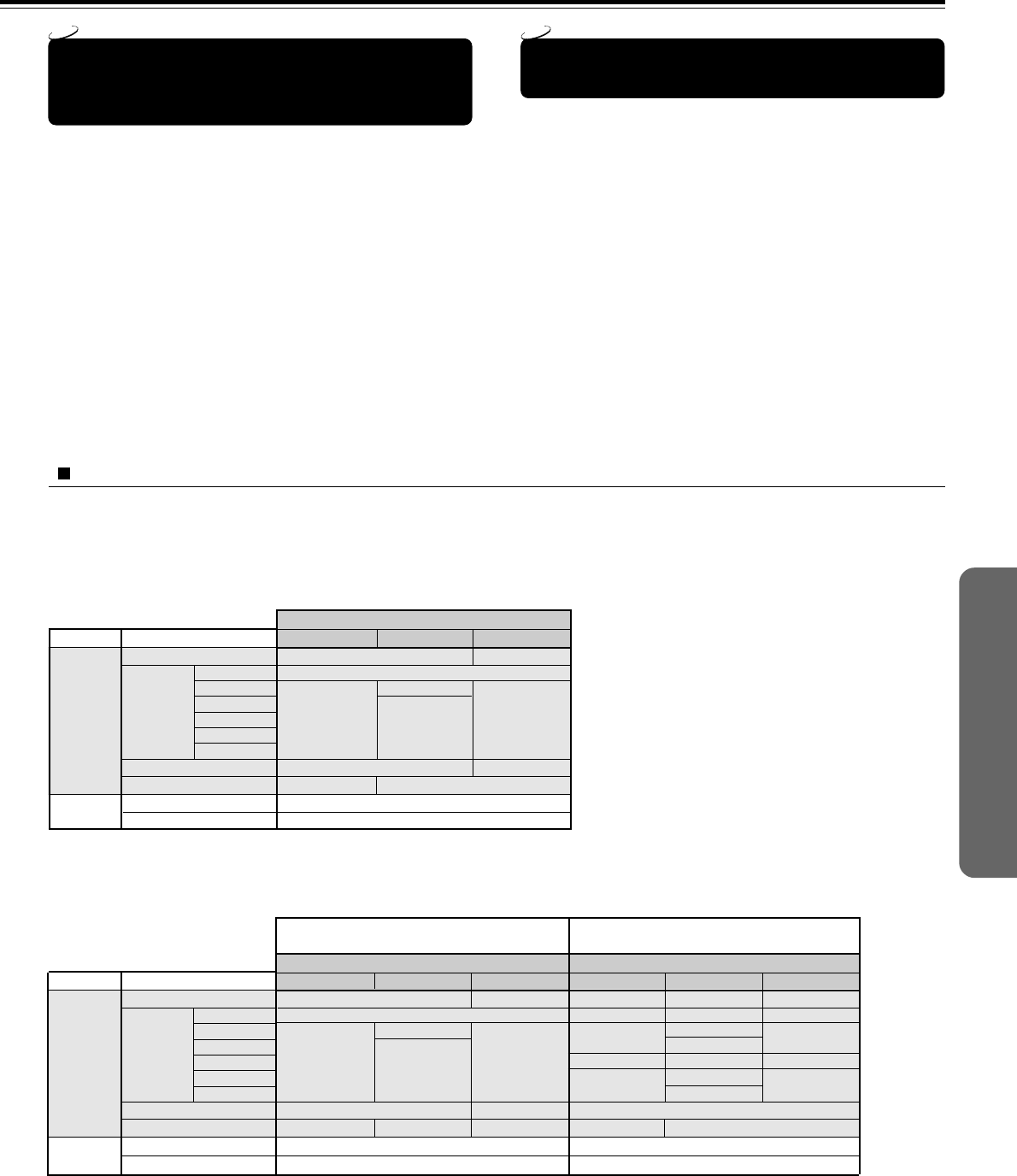
41
Advanced DVD/
Audio CD Operation
Output sound conversion tables
Symbols in the tables
• The symbols a, c, h, and i are referred on the previous page and this page.
• The symbols b, c, d, e, and f are referred on page 59 in “Recording Using the Connected Equipment.”
Sound from the speakers
Sound signals from the Digital output connector and Analog output jacks
Discs
DVD
videos
Linear
PCM
Sound systems*
1
*
1
Some discs have more than one sound system and
can be selected (see page 39).
*
2
You can change the conversion method temporarily
as described on the previous page, or permanently
using the setting menu (see pages 44 and 50).
Conversion methods*
2
Audio CDs
DOLBY DIGITAL
48 kHz/16 bit
48 kHz/20 bit
48 kHz/24 bit
96 kHz/16 bit
96 kHz/20bit
96 kHz/24 bit
DTS
MPEG2
Linear PCM 44.1 kHz/16 bit
DTS
Discs
DVD
videos
Linear
PCM
Bitstream
Bitstream (7.1ch)
Sound systems*
1
96k Sound
48 kHz/16 bit
Bitstream (2ch)
Conversion methods*
2
Bitstream
48 kHz/16 bit 48 kHz/16 bit
kHz/bit when converting Digital Signals to
Analog Signals for Analog jacks
96k Sound
48 kHz/20 bit
48 kHz/16 bit
48 kHz/20 bit
48 kHz/24 bit
96 kHz/16 bit
96 kHz/20 bit
96 kHz/24 bit
PCM
Conversion methods*
2
Digital output signals from
the DIGITAL OUTPUT OPTICAL connector
48 kHz/16 bit 48 kHz/16 bit
No signal is
output.
No signal
44.1 kHz/16 bit
No signal
cb
Bitstream
No Signal
Bitstream
DOLBY DIGITAL
48 kHz/16 bit
48 kHz/20 bit
48 kHz/24 bit
96 kHz/16 bit
96 kHz/20 bit
96 kHz/24 bit
DTS
MPEG2
Linear PCM 44.1kHz/16 bit
DTS
96k Sound
48 kHz/16 bit
PCM
48 kHz/16 bit
No sound
d
a
Changing the DOLBY DIGITAL Surround
Sound Format to the Digitally Recordable
Frequency (kHz)/Quantization (bit)
Change the sound signal conversion method to “PCM”
following the steps in “Changing the Sound Signal Conversion
Method Temporarily” on the opposite page.
Referring to c in the table below, the DOLBY DIGITAL
Surround format will be converted into the 48 kHz/16 bit
format which is recordable.
DVD
PCM
48 kHz/16 bit
No signal
48 kHz/16 bit
48 kHz/20 bit
48 kHz/16 bit
48 kHz/20 bit
48 kHz/16 bit
48 kHz/20 bit
48 kHz/20 bit
48 kHz/16 bit
48 kHz/20 bit
48 kHz/16 bit
48 kHz/20 bit
e
f
f
Same kHz/bit as the source
Same kHz/bit as the source
Same kHz/bit as the source
Same kHz/bit as the source
Audio CDs
48 kHz/16 bit
e
Changing the MPEG2 Sound Format to
the Analog Signals for Recording
Digital recording of MPEG2 sounds is impossible regardless
of the sound signal conversion methods, though, analog
recording of MPEG2 is possible if you change the sound
signal conversion method.
To record MPEG2 sounds from the analog output jacks,
change the sound signal conversion method to “96k Sound” or
“PCM” following the steps in “Changing the Sound Signal
Conversion Method Temporarily” on the opposite page.
Referring to i in the table below, the MPEG2 format will
be converted into the recordable analog signals using the
48 kHz/16 bit format, whereas the MPEG2 sounds are not
output to the analog output jacks when the sound signal
conversion method is “Bitstream” (h in the table below).
DVD
hi
DOLBY DIGITAL
Bitstream
Same kHz/bit as
the source
DTS
DTS
Bitstream
No signal 48 kHz/16 bit


















